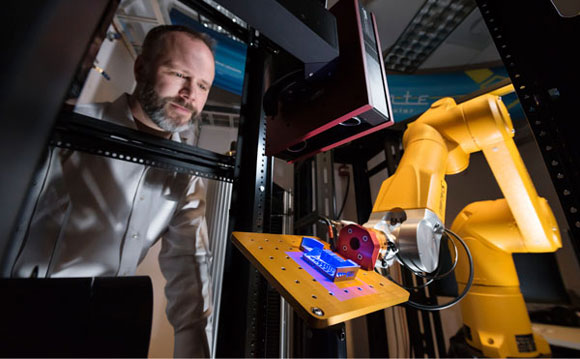Laboratory develops robotic work cell for instantaneous high-throughput testing
June 11, 2018

Sandia materials scientist Brad Boyce watches as the Alinstante robotic work cell scans a metal AM part to compare it to the original design (Courtesy SNL)
Sandia National Laboratories (SNL), New Mexico, USA, managed and operated by the National Technology and Engineering Solutions of Sandia (a wholly owned subsidiary of Honeywell International), reports that it has designed and built a robotic work cell for the non-destructive testing of additively manufactured components. The developers are now seeking partners to help to expand or discover more uses for the robotic testing system, which has been named ‘Alinstante’ (Spanish for ‘in an instant’).
Development of the tool began in 2015, when Brad Boyce, a materials scientist at SNL, was involved in a Laboratory Directed Research & Development-funded project to improve the qualification process for custom metal AM parts. “In traditional manufacturing of metals, there’s a lot of experience and finesse in process control to produce metals with uniform properties. When we went to laser manufacturing we had to take a step back and rethink qualification,” he stated. Though he had already developed a machine for tensile testing, this project required a more generalised and flexible solution.
Boyce quickly decided that automation was key to the development of a quicker qualification process. “Once we committed ourselves to automation, we realised that the barriers could be overcome,” he continued. “Yes, we invested some time and money, but the real challenge was getting ourselves out of the mindset of ‘business as usual’ to understanding that we need a faster solution.”
Alinstante’s work cell is said to be similar to a ‘circular desk’ with a commercial robot at its centre, which can conduct high-throughput testing to quickly determine the performance and properties of a part. The work cell has six sides, comprising six ‘petal’ workstations, each of which can have a different commercial or custom testing system, and can be swapped in and out depending on the kind of testing needed. In addition, because of its hexagonal shape, multiple of the work cell’s petals can be combined in a honeycomb-like structure which allows hand-offs from work station to work station, allowing a large degree of scalability.
The design of the work cell was led by SNL mechanical engineer Ross Burchard, who stated that he explored many different design configurations before settling on the hexagonal petal design. “My challenge was: How do you come up with a work cell with one robot and multiple testing stations that’s also modular and scalable?” he stated. Once the configuration was selected, the first work cell was built, using adapted commercially available hardware wherever possible for efficiency and cost savings.
In addition to constructing the hexagonal floor plate and pedestal for the commercial robot, the team installed safety light curtains wherever a person and the robot might interact. These light curtains are set up so that if a person reaches into the work cell, or if the robotic arm reaches out of the work cell, the light beam is broken and the robot automatically stops moving.
Tim Blada, a roboticist who is leading the design of the software interface, stated that by the close of Summer 2018, he hopes Alinstante will incorporate a user interface which could allow a non-expert to place a part on a tray in the parts rack, select their tests and automatically be provided with the required data. He added that it is important that this software architecture is modular, allowing new modules and tests to be added easily.
The existing prototype of the Alinstante work cell has only two testing stations, and a rack on which users can place their parts. The first station is an off-the-shelf structured light scanner which converts scans into 3D models for direct quantitative comparison to the original intended design. The second station is a load frame for testing physical properties, such as tensile and compression testing. Next, the team stated that it will add a laser-induced breakdown spectrometer to Alinstante, This test is particularly useful for determining the batch-to-batch consistency in the chemical composition of parts in a minimally destructive manner.
“Sandia has testing labs that can perform all of these tests; however, it takes a few weeks to schedule each of them, which can add up to one or two months of testing,” stated Burchard. “Alinstante can reduce the scheduling burden for the testing, greatly speeding up the turnaround time.” Alinstante would also reduce the opportunity for human error, producing data that is more consistent and reproducible than human testers.
In the long-term, Boyce stated that he sees greater potential for Alinstante beyond its initial function as a tool for testing. “Right now, Alinstante is really just scratching the surface of what it could be,” he explained. “We could integrate the printer, processing systems — such as a heat-treat oven or a grinder — and many other post-processing tests. Friday afternoon you tell the 3D printer, ‘I want you to print this part ten different ways and then go test each one.’ You come to come back Monday morning and Alinstante tells you which process was the best. Let the robot do all the logistics work and get the human out of the loop except for making the important engineering decisions.”
















